Eduard 1/48 Roland C.II
'Walfisch'
|
KIT #: |
8446 |
|
PRICE: |
$12.00 MSRP |
|
DECALS: |
One option |
|
REVIEWER: |
Kyle Bodily |
|
NOTES: |
Weekend Edition |
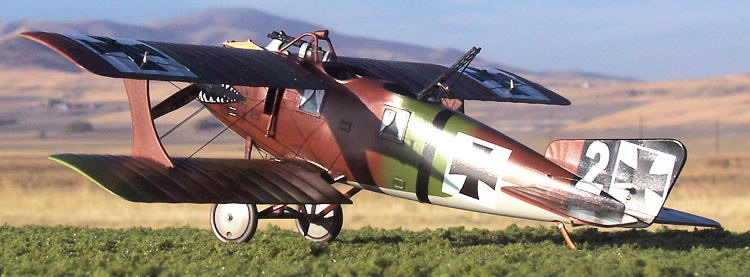
The
Roland C.II is a very important First World War aircraft.
It was probably the first aircraft
that was designed to minimize parasitic drag.
Because of these smooth fish like
lines it acquired the nickname in German for a whale WALFISCH.
The stream line nature made the
Roland C.II the fastest two seater of its day.
In fact it was so fast that it
could operate without a fighter escort since it could out run most any fighter
of its time.
It was not however the best suited
aircraft for dogfighting since the airflow over the body created turbulence that
interfered with the tail surfaces resulting in a loss of tail control surface
effectiveness.
The last batch fixed this problem
with larger tail surfaces
Now
we know that that the space between bi-plane wings needs to be wider then the
chord of the wings to prevent aerodynamic interference between the wings.
What basically happens is the high
pressure from the top wing and the low pressure from the
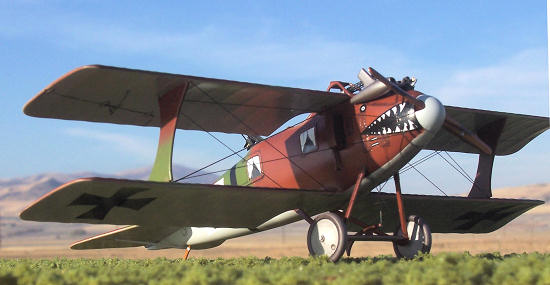 bottom
wing move together causing a stall state between the wings.
Of all the things that Roland could
have done to improve the handling of their C.II it would have been to widen the
space between the wings.
The end results would have been an
aircraft that could have turned and handled much better.
bottom
wing move together causing a stall state between the wings.
Of all the things that Roland could
have done to improve the handling of their C.II it would have been to widen the
space between the wings.
The end results would have been an
aircraft that could have turned and handled much better.
The
biggest negative was that pilots found it hard to land and it suffered from many
landing accidents.
On the other hand the construction
technique pioneered by Roland made for a very robust airframe.
In turn many airframes that were
damaged in accidents were repaired to fly again.
The
C.II was also the parent design to Roland fighters and the entire Pfalz fighter
line from the D.III on.
This is expressed in the very clean
lines of these aircraft.
Roland and Linke-Hofmann Werke AG
built C.IIs and C.IIas
The
first C.II reached the front in March 1916 and were first used in the
Verdun sector.
The aircraft saw front line service
until June 1917 after that you could find them as trainers until 1918.
At
its peak the Germans only operated some 64 Roland C.IIs.
This has always perplexed
historians since like the Fokker Dr.I its numbers and performance do not match
its fame.
I think like the men that died in
the Fokker Dr.I gave the Fokker its fame.
Captain Albert Balls Ahab like
fixation or should I say maybe obsession for hunting the Great White Whales
known as Roland C.IIs made the Roland as famous as Moby Dick.
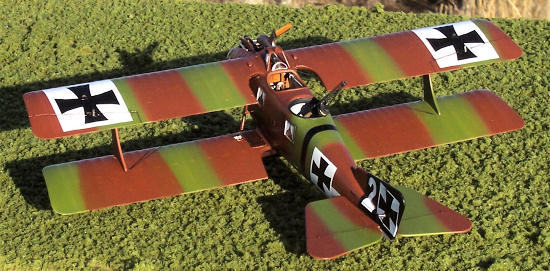 This is
another excellent kit by Eduard.
In the box you get four trees of
the highest quality plastic moldings youíre likely to find anywhere.
Three trees are in a light tan and
one that is clear.
This is
another excellent kit by Eduard.
In the box you get four trees of
the highest quality plastic moldings youíre likely to find anywhere.
Three trees are in a light tan and
one that is clear.
Iíve
seen several reviews on this kit and I bet most of you have read one of them.
So I will keep this curt, but the
quality of this kit is excellent.
No flash, the decals are printed
spot on and the instructions are well done with nice rigging diagram.
The weekend addition gives you nice
color drawings to help in painting.
The
only thing that I question is that Eduard calls for an all wood colored interior
and I have not seen any photographs that show anything but a gray painted
interior.
The only things that Iíve been able
to identify as being in a natural wood finish were the instrument panel, the
floor and the wireless antenna reel.
This kit really went together
well.
I built and assembled all the
entrails as in the instructions.
The only place w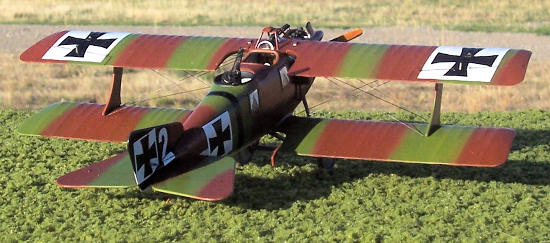 here
I differed from the instructions was to paint the inner parts gray.
I painted the floor and instrument
panel varnished wood.
here
I differed from the instructions was to paint the inner parts gray.
I painted the floor and instrument
panel varnished wood.
The
fuselage halves went together very well.
The only difficulty was just
sanding the seam around the gun ring.
I
glued on the lower wings and after they had dried I applied some filler putty
and polished the joint with finger nail polish remover.
I find that this process gives you
a smooth joint very quickly.
I
painted the model and finished the assembly process.
The rigging is quite simple since
the design of the Roland C.II eliminated the need for cabane struts.
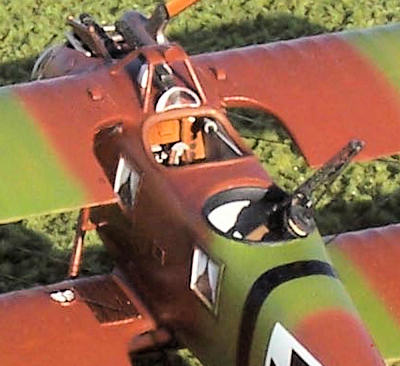
I painted the model to match
the art work on the box.
I used a home mix of paint to
achieve the shade of green and brown that I used.
I weathered the model and applied a
final coat of semi-gloss clear finish.
The decals went on with out a
hitch.
They settled down and adhered like
they were painted on.
For
the propeller I painted it raydome tan then hand painted the laminations with
raydome tan mixed with some leather brown.
I think this process looks good for
the laminations.
Iíve
built this kit many times in the past and find it more and more a joy each and
every time I build it.
It goes together well with little
fuss.
The
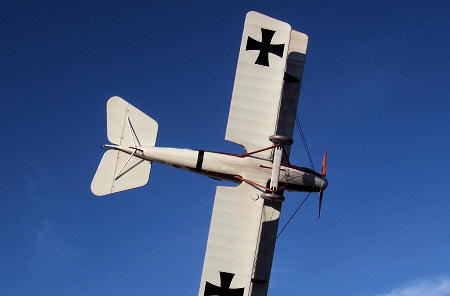 decals
work perfectly.
The new weekend addition lets you
purchase one for around twelve dollars.
Eduard deserves a big thank you and
much praise for putting such well engendered kits in the hands of modelers at
such a great price.
This model is highly recommended
and would be a good kit for an inexperienced modeler who wants to build a
biplane, and a very important one at that.
decals
work perfectly.
The new weekend addition lets you
purchase one for around twelve dollars.
Eduard deserves a big thank you and
much praise for putting such well engendered kits in the hands of modelers at
such a great price.
This model is highly recommended
and would be a good kit for an inexperienced modeler who wants to build a
biplane, and a very important one at that.
Besides, for twelve
dollars you donít have to worry about making mistakes and throwing away your
investment.
ďWindsock Datafile #49 LVG Roland
C.IIĒ Albatros Productions LTD
ďJaneís All the Worlds Aircraft 1919Ē (Janeís Fighting Aircraft of World War I)
Kyle Bodily
Copyright ModelingMadness.com. All rights reserved. No reproduction in any form without express permission from the editor.
If you would like your product reviewed fairly and quickly, please
contact the editor or see other details in the
Note to
Contributors.
Back to the Main Page
Back to the Review Index Page2025


 bottom
wing move together causing a stall state between the wings.
Of all the things that Roland could
have done to improve the handling of their C.II it would have been to widen the
space between the wings.
The end results would have been an
aircraft that could have turned and handled much better.
bottom
wing move together causing a stall state between the wings.
Of all the things that Roland could
have done to improve the handling of their C.II it would have been to widen the
space between the wings.
The end results would have been an
aircraft that could have turned and handled much better.
 This is
another excellent kit by Eduard.
In the box you get four trees of
the highest quality plastic moldings youíre likely to find anywhere.
Three trees are in a light tan and
one that is clear.
This is
another excellent kit by Eduard.
In the box you get four trees of
the highest quality plastic moldings youíre likely to find anywhere.
Three trees are in a light tan and
one that is clear.
 here
I differed from the instructions was to paint the inner parts gray.
I painted the floor and instrument
panel varnished wood.
here
I differed from the instructions was to paint the inner parts gray.
I painted the floor and instrument
panel varnished wood.
 decals
work perfectly.
The new weekend addition lets you
purchase one for around twelve dollars.
Eduard deserves a big thank you and
much praise for putting such well engendered kits in the hands of modelers at
such a great price.
This model is highly recommended
and would be a good kit for an inexperienced modeler who wants to build a
biplane, and a very important one at that.
decals
work perfectly.
The new weekend addition lets you
purchase one for around twelve dollars.
Eduard deserves a big thank you and
much praise for putting such well engendered kits in the hands of modelers at
such a great price.
This model is highly recommended
and would be a good kit for an inexperienced modeler who wants to build a
biplane, and a very important one at that.